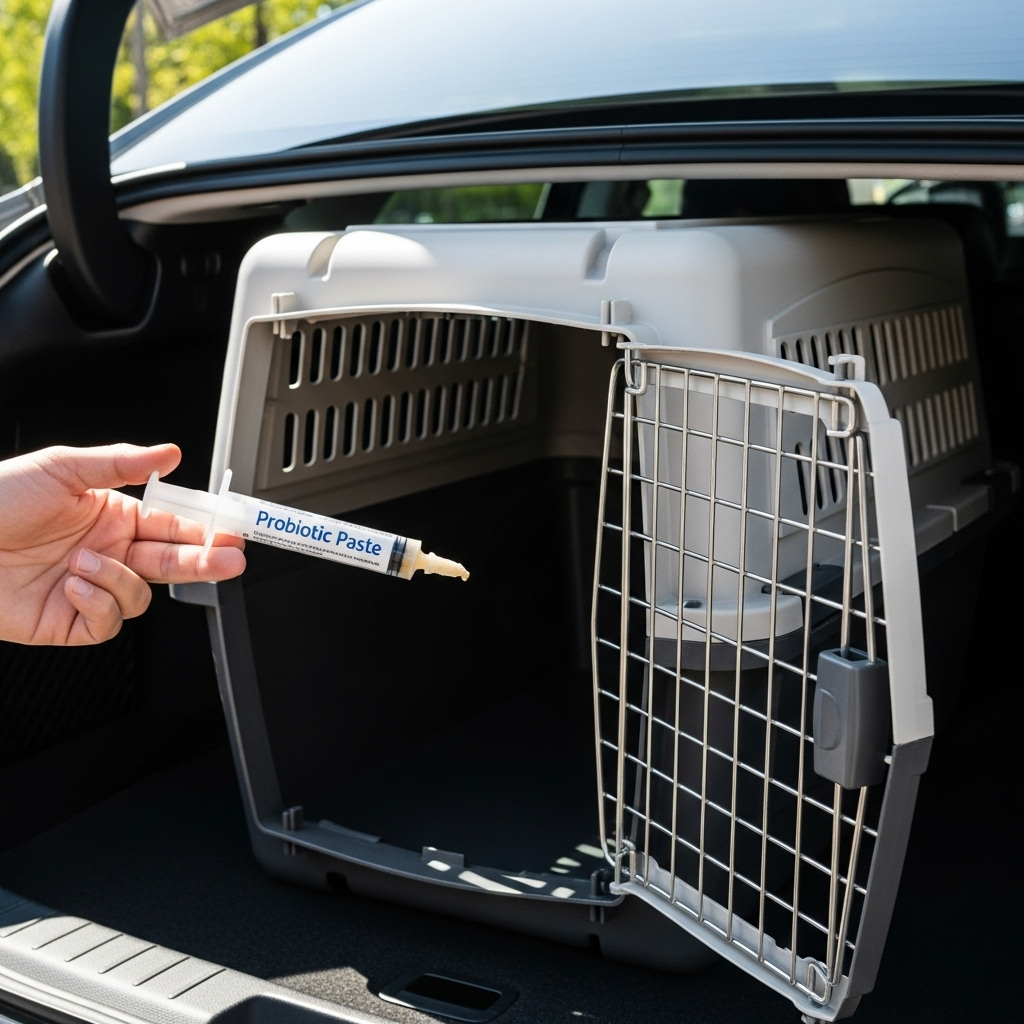Probiotic Paste for Dogs: Travel-Day Tummy Rescue

Travel can be stressful for dogs. New smells, motion, different food and water, and anxiety all raise the chance of loose stool or mild diarrhea on the road. A probiotic paste formulated for dogs can be a convenient, fast-acting option to help rebalance gut bacteria on travel day or as a short-term emergency measure. This guide explains what probiotic paste is, when and how to use it safely, and when you should seek veterinary care.
What is a probiotic paste for dogs?
Probiotic pastes are chewable or smearable formulations that contain live beneficial bacteria and sometimes prebiotics (food for the bacteria). They are designed to be palatable and easy to administer directly into your dog’s mouth or on food. Common genera included in dog probiotics are Enterococcus, Lactobacillus, and Bifidobacterium, though exact strains and colony forming unit (CFU) counts vary by product.
How they help (in simple terms)
Probiotics may help by competing with harmful bacteria, supporting digestion, and helping maintain a balanced gut microbial environment. On travel day, the goal is often to reduce the duration and severity of mild diarrhea and to support normal stool consistency while your dog copes with temporary stressors.
When to use probiotic paste on travel day or for emergency diarrhea
- At the first sign of mild, non-bloody loose stool during travel.
- When your dog shows mild stomach upset after a change in food, water, treats, or a stressful event like a long car ride or plane travel.
- As a short-term supportive measure when you’re far from your regular veterinarian and need a low-risk option to try while monitoring your pet.
When NOT to rely on probiotic paste
Do not use probiotic paste as a substitute for veterinary care if your dog has: bloody diarrhea, frequent vomiting, signs of dehydration, fever, severe abdominal pain, collapse, marked lethargy, or if the dog is a young puppy, elderly, or has a weakened immune system or serious chronic disease. These require prompt veterinary evaluation.
How to choose and use a probiotic paste for travel
Choose a product specifically labeled for dogs with clear dosing instructions. Look for products that list the type of organisms and CFU count at the time of manufacture and those made by reputable pet supplement manufacturers. Check for palatability (paste vs. chew) and shelf-stability—some pastes are shelf-stable while others require refrigeration after opening.
Administration tips
- Follow product label dosing by weight. If unsure, consult your veterinarian for a recommended product and dose.
- If your dog is on antibiotics, give the probiotic paste 2–3 hours after the antibiotic dose to improve the chance the probiotic bacteria survive.
- For travel prevention, consider starting a probiotic 3–7 days before travel to allow the gut environment to adjust. For same-day emergencies, give the paste at the first signs of loose stool — it may take 24–72 hours to notice improvement.
- Offer water and monitor food intake. Avoid offering rich or unfamiliar foods during an episode.
Storage and packing advice for travel
Pack the paste in an easy-to-access part of your travel kit (not buried in luggage). Keep refrigerated if the product requires it; otherwise, store at room temperature away from heat. Bring the dosing instructions, a small measuring tool if needed, and a way to dispose of used packaging. Also have your vet’s phone number and local emergency clinic contacts for your travel area.
Safety, side effects, and special considerations
Probiotics are generally considered safe for healthy dogs and side effects tend to be mild—transient gas or soft stools when first introduced. However, there are important considerations:
- Dogs with severely compromised immune systems or who are critically ill should not receive live bacterial supplements without veterinary approval.
- If diarrhea worsens, becomes bloody, or is accompanied by vomiting, lethargy, or dehydration, stop the paste and seek veterinary care.
- Probiotic strains differ in effects; if your dog responds poorly to one product, another formulation or strain might be better—ask your veterinarian.
Pros and Cons
| Pros | Cons |
|---|---|
| Easy to administer and travel-friendly | Not a replacement for veterinary care in serious cases |
| May shorten duration of mild diarrhea and support gut balance | Variable strains and quality between products |
| Generally safe for healthy dogs | May cause mild gas or softer stools initially |
When to contact your veterinarian
- If diarrhea lasts more than 48 hours or worsens.
- If you see blood in the stool or your dog vomits repeatedly.
- If your dog shows signs of dehydration (dry gums, decreased skin elasticity, sunken eyes), fever, weakness, or severe abdominal pain.
- If your dog is a puppy, elderly, pregnant, or has serious health issues.
FAQ
Q: Can I give probiotic paste to my dog the same day we travel?
A: Yes. For mild, travel-related upset you can give a probiotic paste on travel day as a supportive measure. For best preventive effect, some owners start probiotics several days before travel.
Q: How long until I see improvement after giving probiotic paste?
A: Some dogs show improvement within 24–72 hours. If there’s no improvement or symptoms worsen, consult your veterinarian.
Q: Are probiotic pastes safe with antibiotics?
A: They can be used alongside antibiotics, but give the probiotic a couple of hours after the antibiotic dose to reduce the chance the antibiotic kills the probiotic bacteria.
Q: Can I give human probiotic paste to my dog?
A: It’s safer to use a product formulated for dogs. Human formulations may contain strains, dosages, or other ingredients that are not ideal for dogs. Ask your vet before using human products.
Key Takeaways
- Probiotic paste can be a convenient, low-risk option for mild travel-day tummy troubles in otherwise healthy dogs.
- Start a probiotic several days before travel for prevention; use it at first signs of loose stool for emergency support.
- Follow product dosing by weight and separate dosing from antibiotics by a few hours.
- Watch for red flags (bloody stool, repeated vomiting, dehydration) and seek prompt veterinary care when they occur.
- Consult your veterinarian for product recommendations, dosing, and if your dog has health concerns or is very young/elderly.
Disclaimer: This information is educational and not a substitute for professional veterinary advice. If your dog shows severe symptoms or if you are unsure about using a supplement, contact your veterinarian or an emergency veterinary clinic promptly.

Leave a Reply